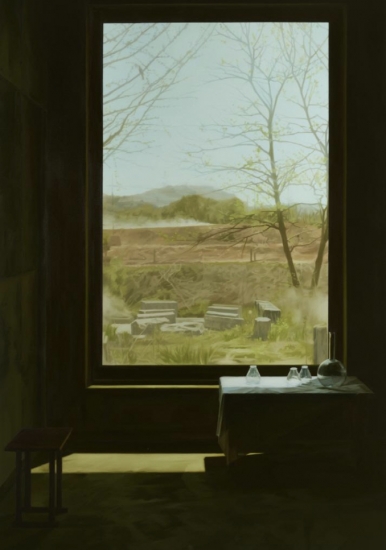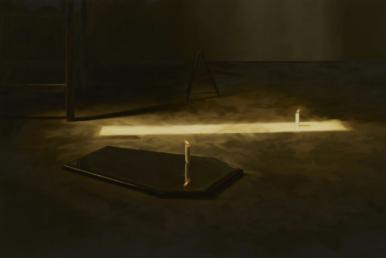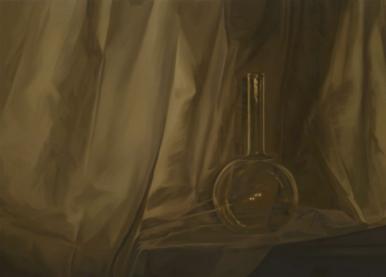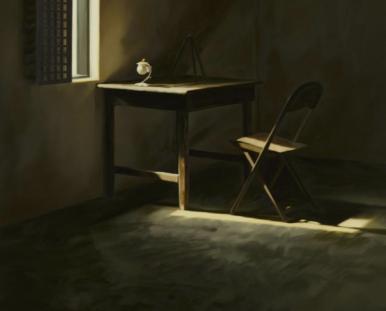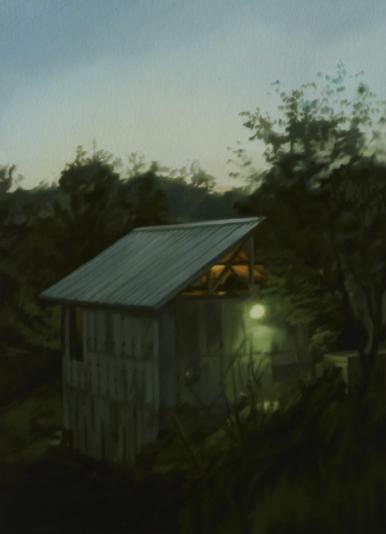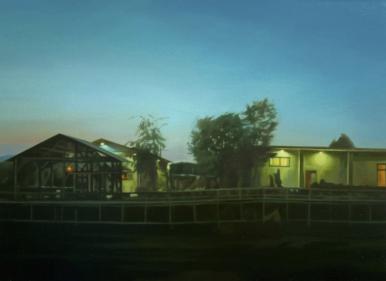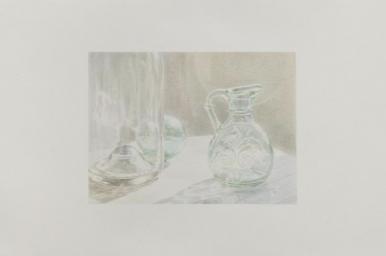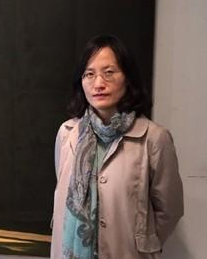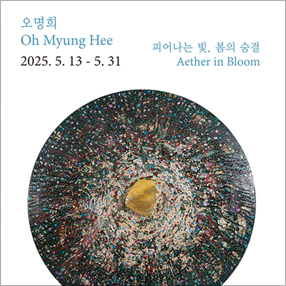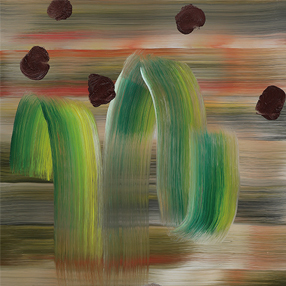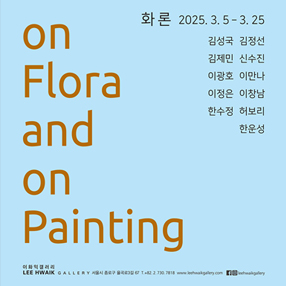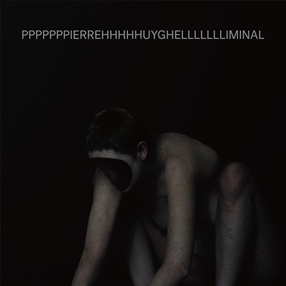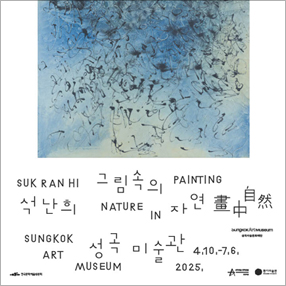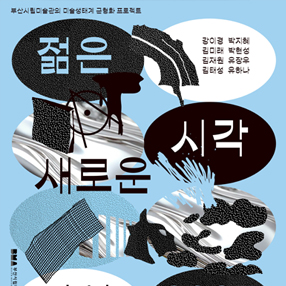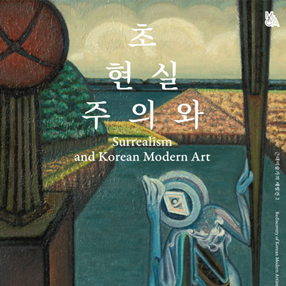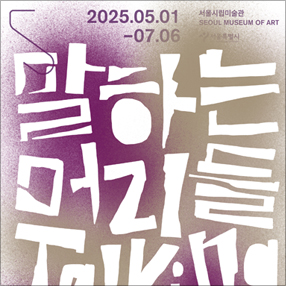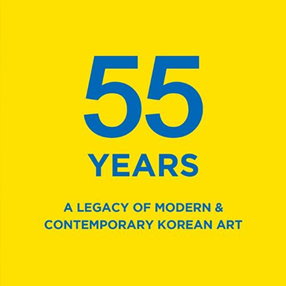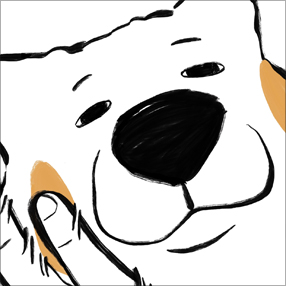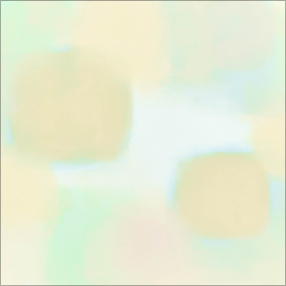본문
-
정보영
Gaze from the ruins 캔버스에 유채_194×130cm_2020
정보영
Lighting up 캔버스에 유채_97×145cm_2020
정보영
Obscured 캔버스에 유채_130.3×227cm, 2020
정보영
Obscured 캔버스에 유채_72.7×100cm, 2020
정보영
Looking 캔버스에 유채_112×162cm, 2020
정보영
Blue hour 캔버스에 유채_33.3×21.2cm, 2020
정보영
Blue hour 2 캔버스에 유채_33.3×21.2cm, 2020
Press Release
빛의 결, 창을 열다
"화가 정보영의 작품에서 창문이나 리플렉스를 통한 빛의 작용은 상징적 의미를 띤다. 건축과 배경이 단색화하기 때문에 빛의 의미는 더욱 강조된다. 사각형의 창문은 알베르티(Leon Battista Alberti)의 유산이자 그림 속의 그림, 시공의 소통, 문화의 만남, 지식의 체계, 비물질화의 증거, 정신적 확대경, 실재 또는 그 너머의 기호라는 말로 바꾸어 쓸 수 있다. 요컨대 창문들은 시선을 유인하면서 시점을 암시하는 출발과 도착의 눈들이다. 해질 무렵 산등성이 능선 바깥의 어슴푸레한 빛, 그리고 창문을 통해서 마룻바닥에 기하학적인 도형을 새기는 빛도 은유적인 의미에서 창문의 범주에 포함된다."
- 노성두, "시선의 주재자", Still Looking, 이화익 갤러리, 2007
괴테(Johann Wolfgang von Goethe)가 죽음을 맞기 전 했던 마지막 말은 "침실의 창문을 열어라. 좀 더 빛을…"이었다. 그가 말한 '빛'이 무엇이었는지 정확히 알 길 없지만 여러 가지로 해석 가능하다. 괴테에게서처럼 많은 이들에게 빛은 물질적으로든, 정신적으로든 의미심장한 존재다. 1997년 첫 개인전을 시작으로 현재까지 '회화의 공간재현'에 몰입해온 작가 정보영에게 빛은 중요한 작업의 테제이다. 빛은 어둠과 만나면서 색을 생성시키는 작용인(作用因)인 것처럼 작가에게 재현의 실질적인 행위이자 존재론적 생성을 이끄는 주체이다. 작가는 줄곧 이 빛에 따라, '실재의 부재'를 건축적 비정형의 공간, 사건, 촛불, 오르골, 유리구슬 등으로 극사실적 또는 환영적 재현을 이어왔다. 특히 근작들은 이 같은 모티프들과 테크닉에서는 공통적이지만 2012년부터 빛을 통해 공간을 점유하고 대상을 관통하는 다른 시선과 재현을 실험하고 있다. 즉, 그간의 시선과 대상, 소실점의 소거, 조형 도식을 선택적으로 종합하거나 회화적 사건의 긴장감을 재현하는 것으로 보인다. 이는 작가의 또 다른 한 시기를 예고하고 있는 것은 아닐런지 조심스럽게 추측해본다. 그렇다면, 작가의 작업은 어떤 맥락으로 회화 재현에의 고전, '그린다는 것'의 탐구를 이어가고 있는지를 독해하지 않을 수 없다.
작가는 초기시대라 할 수 있는 1997~2003년까지 대체로 사물의 재현과정을 분석하는 데 집중했다면, 2004~2011년까지 '시간화된 공간'으로 실재하는 공간과 부재하는 공간을 공존시키고자 했다. 2012년부터 현재까지는 '빛의 결'을 통한 실재의 재현에 다다르고 있다. 크게 3시기로 구분하고 있지만, 초기부터 일관되게 작가의 평면에는 자신의 시선에 의한 빛과 공간의 결구(結構)가 이어진다. 제1기(1997-2003)의 작업들은 사물의 재현 과정을 통해 부재가 드러나는 방식을 갖고 있다. 재현은 화자(painter)와 화면(畵面) 그리고 대상(對象)을 기본구도로 하여 상징물을 통해 제시되며, 「반복, 지루함, 단조로움 1995」 「사물에의 의지 1996」 「대상에 대한 반복충동 1996」 「공간의 죽음 1997」 「거울 1997」 「미친 질주 1997」 「일시점에 의해 고안된 완벽한 공간, 그것의 열림 1999」 「깊은 공간으로부터 1999」 「전망이 다른 두 개의 창 2000」 「너무 늦은, 혹은 너무 이른 1999/2000」 「보이지 않는 창문 2000」 「겹쳐지다 2001」 「방문 2003」 등이 그 예들이다. (※1997~2001 개인전 도록 참조) 이들 실재와 부재의 공간에서 캔버스와 이젤은 재현의 주체가 되고, 모과·복숭아·사과는 재현의 대상, 거울은 주체의 환영, 붉은 천은 욕망으로 알레고리화 되어있다. 작가의 공간은 이미 페르메이르(Johannes Vermeer)와 벨라스케스(Diego Rodríguez de Silva Velázquez)의 바로크적 공간과 대상의 표상 작용을 상기시킴과 동시에 키리코(Giorgio de Chirico)의 무드를 장착하고 있다. 작가 스스로 이와 같은 재현은 초기 '대상에의 접근하는 가장 치열한 형태로서의 재현', 중간 시기 '재현에 대한 상상계적 탐닉', 후반부에 '공백을 둘러싼 어떤 양태의 모험'으로, 궁극에 '공백'에의 깨달음에 다다랐다고 하였다. 다분히 라캉(Jacques Lacan)의 이론이 투영된, 사실적이나 환영적인 작업들에서 '공백'은 '실재'로 위치하면서 동시에 '부재'를 전면화하는 특질이다. '공백'은 공간과 시간의 계기를 중첩하는데, 하나의 시공간, '크로노토프(chronotope)'이다. 불연속적 시점과 시간적 차이를 통해 작가 스스로 '시간화된 공간'이라 칭한 화면으로 나아가기 때문이며, 바로 다음 시기의 핵심적 요소인 빛과 공간의 전면화를 예고한다.
제2기(2004-2011)의 작업들은 실재하는 건축물의 공간과 시간을 통한 부재를 표상한다. 실재하는 건축물을 도입하여 공간 자체를 재현하는 것을 우선적 목표로 하였던 작가는 화자(painter), 화면, 공간과 현전할 수 없는 연관성을 표상하였다. 시간, 사건, 얼룩, 부재를 암시하는 소재들이 등장하고 소실점으로 이어진 공간의 구축성은 와해된다. 다만 재현의 대상으로 선정된 건축물, 그 내부로 빛의 유입은 보다 중요한 재현의 메커니즘이다. 빛은 물리적 공간과 결합하고 부재를 화면에 드러내는 근원으로서, 빛의 각도와 양에 따라 어둠의 영역도 구조화된다. 즉 작가는 스스로 얘기한 것처럼, '창을 통해 유입되는 자연광', '대기 속에 퍼져있는 자연광', '실내조명의 인공광', '촛불의 빛'이라는 네 가지 빛의 유형으로 탐색하였다. 특정한 건축적 공간의 창과 동선 그리고 풍경과의 연결까지 다층적 시선과 빛의 흐름은 시간의 사건을 조성한다. 예컨대 빛의 중첩은 시간의 중첩임을 「사라지다 2006,2008」의 바닥면에 쌓인 빛의 층으로 재현한다. 실제 공간의 환경이 거울 이미지화된 또 다른 환영으로 동시에 제시되거나, 시간의 흐름에 따라 변화하는 건축물 표면과 내부의 얼룩에 이르기까지 공간의 고요한 외침은 연속된다. 즉 「흐르다 2003,2004,2007」 「바라보다 2004,2007,2008」 「세우다 2005,2007」 「사라지다 2006,2008」 「어떤 조망 2007」 「또 다른 시선 2007」 「바라보다 2007」 「밝은 방 2007」 「먼, 혹은 가까운 2008」 「지나가다 2010」 등이 그 예들이다. (※2003~2011개인전 도록 참조) 얼룩, 촛불, 연기, 의자, 오르골 등이 등장하는 화면에서 이들 소재들은 부재를 지시하며 무엇인가를 재현하는데 이것이 곧 드러냄과 사라짐의 재현 행위라는 것이다. 예컨대 건축물 벽 등에서 얼룩은 작가에게 '응시의 덫'으로 전환되고, 재현된 그림의 구조를 결정하고 통제하는 요소가 된다. 작가의 소재 중 하나인 촛불은 빛이라는 존재의 밝힘과 동시에 사라짐이라는 부재 사이의 연접을 드러내는 지표로 작용한다. 연기는 '사라짐' 부재의 상징으로 드러나며, 빈 의자는 곧 부재를 암시하는 매개물로 기능한다. 오르골은 소리의 울림을 수반한 이미지의 응시가 이루어지는 지시물이다. 빛이 기투 되는 실내와 시간에 따라 변화하는 풍경에 이르기까지 이들 모티프들이 함께 하는 공간은 건축물 투시면, 원근법적 환영이 아닌 재현된 부재의 응시로 이끈다.
제3기(2012-2020)의 작업들은 비교적 최근까지 빛의 기투와 시선의 메커니즘, 즉 중첩과 반사의 공간적 재현과 '빛의 결'로 아우러지는 환영을 불러일으킨다. 2012년 『빛, 시간의 경계』 (2012.10.10.-10.23 이화익갤러리), 2015년 『빛과 부재의 서사』 (2015,11.4-11.24 이화익갤러리), 2016년 『푸른 시간』 (2016.10.27.-11.24 갤러리 미고), 『흩어지다』 (2019.12.11.-12.21 스페이스몸 미술관), 그리고 2020년 『빛의 결, 창을 열다』 (2020.10.14.-27 이화익갤러리) 전시까지 일관된 작가의 테제는 빛의 실재와 부재, 응시와 재현이다. 2012년 「다가오는 혹은 사라지는 2012」 「다가오다 2012」 「세우다 2012」 「겹쳐지다 2012」 「푸른 시간 2012」 「열다 2012」 「열다 혹은 닫다 2012」 「고요히 바라보다 2012」 (※2012개인전 도록 참조) 등의 작업들에서는 이전 시기까지 건축적 공간의 시간과 빛이 중첩되는 가운데, 실내외로 드리워진 공간과 빛의 깊이를 화면의 전후로 전개하는 면들의 적층이 자연스러운 장면이 되게 한다. 시선을 빛과 마주하게 하거나, 빗겨서 보거나 적어도 한 공간에서 다음 공간으로 거리가 전제되며 그에 따른 색과 면의 깊이는 재현의 뉘앙스를, 얼룩과 빛의 그림자는 실존의 흔적을 음미케 한다. 2015년 무렵 작가의 빛은 「투명한 그림자」 시리즈에서 전면화 된다. 빛이 드는 창으로부터 유리 오브제의 선명함, 나아가 유리 오브제에 부딪히는 빛의 파동을 드러내는 '빛의 결'이 파문을 이루듯 퍼지기 시작한 것이다. 유리창을 사이에 두고 실내와 실외를 마주하게 하며 표면에 묻어나는 반사문(頒賜文)은 빛 얼룩처럼 흐릿하거나 뭉게지는 면들까지 부드럽게 조각하듯 그려낸다. 「고요히 바라보다 2014」 「또 다른 시선 2015」 「수직적 시간 2015」 「보이지 않는 시선2015」 「어떤 조망 2015」 (※2015개인전 도록 참조) 등의 작업들에서 화면의 대상들과 빛의 구도는 공간과 오브제의 총체적 재현의 장면으로 이끈다. 극적인 긴장을 만들며 빛과 어둠의 공간은 스며들 듯 깊게 시선을 화면의 안쪽으로 유인한다.
이어 2016년 「창을 통해 바라보다 2016」는 실내의 풍경에 창문을 중심축에 세우고 앞뒤로 유리구슬을 위치시킨다. 실재하나 부재하는 재현의 실내는 유리창문과 유리구슬, 플라스크 등으로 빛을 관통하는 그림자의 극도의 섬세함에 도달한다. 광학적 장치 개발자에게 투과와 반사 그리고 흡수의 층들은 어떻게 표출할 것인지를 해제하듯 시선과 빛면을 교호케 한다. 한발 더 나아가 밝음과 어둠의 경계에서 유리구슬이 투명한 타원형의 그림자를 드리운 「투명한 그림자 2016」(37.9×45.5cm)는 빛의 왜상과도 같다. 또한 실외로 나간 주체의 시선은 건축물의 인공 빛과 저녁 하늘의 푸른 색채, 내부의 빛으로 완성된다. 이 「푸른 시간」시리즈는 어두워진 실외 풍경과 실내에서의 빛이 경계 지점에서 어둠의 깊이가 보다 선명하게 재현된다. 이와 대조를 이루는 「세우다」시리즈는 촛불과 창문의 빛이 공존하며 밝음의 깊이가 간명하게 드러난다.(※2016개인전 도록 참조) 촛불의 불꽃을 마주하는 자연의 빛, 밝음 속의 그림자, 창을 통해 실내로 잠입한 빛의 점유면은 작가의 선제된 시선의 결구 장치와 오랜 관찰에 의해 도달한 실재와 부재의 현존을 융합한 장면이다. 「지나가다 2017」 「한계지어지다 2019」(※2019개인전 도록 참조) 등의 2019년 전시에 이어 2020년 전시작인 「투명한 그림자 2020」 「고요히 바라보다 2020」 「바라보다 2020」 「가리어지다 2020」 「흩어지다 2020」 「세우다 2020」 「폐허로부터의 시선 2020」 「푸른 시간 2020」 등은 빛과 어둠, 실내와 실외, 대상과 그림자, 모아짐과 흩어짐, 안으로부터 밖, 밖으로부터 안, 이쪽과 저쪽, 안쪽과 바깥쪽, 대상과 시선, 유리와 벽, 공간과 사물 등의 일련의 관계들이 공존과 중첩의 조화로운 화면을 이끌며 하나의 완결에 이르고 있다. 특히 「폐허로부터의 시선 2020」의 경우, 특별할 것 없는 일상의 장면으로 지각되지만 창문 너머에서 창문을 비추는 빛의 시선을 따라가다 보면 흰 테이블 위의 유리 오브제가 발견된다. 풍경으로부터 정물로, 자연으로부터 인공의 공간으로 일체가 된 화면이다. '바라봄'의 두 시선이 하나로 만나는 그 지점이 창이다. 알베르티에게도, 페이메이르에게도, 작가에게도 창은 세계를 보는 눈을 넘어, 세계가 만나는 지점인 것이다. 「가리어지다 2020」의 길게 드리워진 천들이 겹겹이 둘러싸여진 공간에 깊고, 넓은 바람이 리드미컬하게 불어온다. 연극의 다음 막을 기다리는 순간처럼 작가의 또 다른 실험과 완결을 기다리게 한다.
"되돌아보면, '사실성(reality)을 향한 충동'이 그림의 큰 부분을 지배해왔던 것 같다. 정확히 말하면 빛에 여과된 사실성, 연출된 사실성일 것이다. 텅 빈 공간 혹은 사물에 드리워지는 빛, 시간에 따른 대기 색조의 변화만큼 그리기에 대한 충동을 주는 요소는 없었다. '빛을 그린다는 것은 동시에 그림자를, 그림자를 그린다는 것은 동시에 빛을 그린다는 것이다.' 오랜 시간 정물을 빌어, 공간을 빌어 빛을 그려온 지금, 지극히 근본적이고 자명한 이 문구를 떠올리게 된다." ( 정보영, 『흩어지다』 스페이스몸 미술관 2019 ) ■ 박남희
Light rays, upon the window opened
Johann Wolfgang von Goethe's last words on his deathbed were "Open the second shutter so that more light may come in." While it's unknown what he meant by this "light", it can be interpreted in various ways. For many, like Goethe, light is a meaningful presence whether it's physical or psychological. For Jeong, an artist who has immersed herself in the "reproduction of space through painting" since her first solo exhibition in 1997 to present, light is an important subject in her work. For the artist, light is an efficient cause that generates colors as it meets darkness, and is both a practical act of representation and a subject that leads to ontological creation. Jeong has continued to portray 'the absence of reality' in hyper-realistic or illusory way through architecturally atypical spaces, events, candles, orgels and glass balls. Of special note, while this also applies to Jeong's recent works in terms of motif and technique, her works since 2012 experiment with other perspectives and representations that occupy space and penetrate the subject through light. In other words, it seems that they selectively synthesize the perspective, subject, elimination of vanishing point, and formative schema, or reproduce the tension of a pictorial incident. One might carefully assume that these works are a pointer to another chapter in the artist's oeuvre. And if so, I can't help but try to understand in what context she is trying to pursue her exploration into the classical gesture of reproduction in painting, or 'the act of painting'.
While the works from the artist's early period from 1997-2003 focus on mainly analyzing the reproduction process of objects, her works from 2004-2011 attempt to portray a 'temporalized space' where real space and absent space coexist. From 2012 to present, the artist is approaching the reproduction of the real through 'light rays'. While Jeong's oeuvre is divided into 3 periods, what is common in her works from the beginning is that the structure of light and space based on the artist's perspective is persistently shown throughout her practice. The works from the 1st period (1997-2003) demonstrate a sense of absence through the process of reproducing objects. In these works, the painter, painting and the subject become the basic composition, and representation is done through symbols. Examples of such works in this period are repetition,samness,monotony (1995), Will of objects (1996), Repetitive impulse on object (1996), Death of space (1997), Mirror (1997), mad rush (1997), Perfect space based on a fleeting moment, and its opening (1999), From a deep space (1999), Two windows with different views (2000), Too late, or too soon (1999/2000), Invisible window (2000), Lie one upon another (2001), and Visit (2003), etc. In the space of presence and absence, the canvas and easel become the subject of representation, while the quinces, peaches and apples become the object of representation, and the mirror connotes an allegory of illusion and the red fabric, desire. These spaces remind the viewer of the baroque-style space and usage of symbols in the objects as often exemplified in the works by Johannes Vermeer and Diego Rodríguez de Silva Velázquez, and are charged wit the mood found in works by Giorgio de Chirico. The artist herself claimed that representation was 'the most intense form of approaching the subject' in her early period, an 'imaginative indulgence in representation' in the middle period, and 'a type of adventure surrounding emptiness' in the later period, and that ultimately, she'd arrived at the state of awareness in emptiness. In realistic and illusory works, which are reflective of Jacques Lacan's theory, 'emptiness' makes its presence, while accentuating 'absence'. 'Emptiness' overlaps space and time, and becomes a single space-time, or 'chronotope'. Jeong's work propels towards the image she herself calls 'temporal space' through discontinuous vision and difference in time, and foretells the frontalization of light and space, which is the core elements of her works in the next period.
The works of the second period (2004-2011) in Jeong's oeuvre represent absence through the space and time of actual architecture. The artist's primary goal was to introduce the actual architecture to represent the space itself, and presented a connection that can never be representable to the painter, painting and space. The subjects that suggest time, event, stain and absence emerge, and the constructivity of space made of vanishing points is collapsed. However, the architecture chosen as the subject of representation, and the inflow of light into the space become an important mechanism of representation. Light is a source that is combined with the physical space to expose a sense of absence, and the area of darkness becomes structured according to the angle and intensity of light. The artist explores light in her own words and explains it in the following four types: 'natural light passing through the window', 'natural atmospheric light', 'artificial indoor lighting', and 'candlelight'. The multi-layered gaze and the flow of light create the event of time, from the windows of a specific architectural light, to the spaces of movement within it and its connection to the landscape. For example, the piling of light on the floor in Disappearing (2006/2008) represents the piling of time. The silent cry of space continues, from the real space simultaneously presented as another illusion in a mirror image, to the surface of architecture and stains in its interior which change with the flow of time. Examples of this can be found in Flowing (2003/2004/2007), Looking (2004/2007/2008), Lighting up (2005/2007), Disappearing (2006/2008), A certain view (2007), Another looking (2007), Looking (2007), Bright room (2007), Distant, or close (2008), and Passing by (2010). In the images where stains, candles, smoke, chairs and orgels appear, such subjects both indicate absence and represent something, which is the appearance and disappearance of the gesture of representation. For example, the stains on the walls of architecture convert into 'traps of gaze' for the artist, and become an element that determines and controls the represented structure in the painting. Candlelight, one of the subjects in Jeong's work, functions as an indicator of the connection between the light of presence and its absence or disappearance. Smoke becomes a symbol of absence or 'disappearance', and the empty chair functions as a medium that implies absence. The orgel is an object that reflects the gaze of an image, accompanied by the reverberation of sound. From the interior where light is projected, to the landscape changing with time, the space where these motifs work together leads one to the gaze of the represented absence rather than the projective side or perspective illusion of architecture.
The works of the third period (2012-2020), until relatively recently, bring about the illusion through the blueprint projection of light and mechanism of the gaze, that is, the spatial representation of overlapping and reflection, and the 'light rays'. Presence and absence of light, gaze and representation are the consistent themes that run throughout the artist's works shown in exhibitions such as Light, the Border with Time (2012.10.10.-10.23 LEE HWAIK GALLERY), Light, the Narrative of Absence (2015,11.4-11.24 LEE HWAIK GALLERY), Blue Hour (Gallery Migo, 2016.10.27.-11.24), Scattered (2019.12.11.-12.21 Spacemom Museum of Art), and Light rays upon the window opened (2020.10.14.-27 LEE HWAIK GALLERY). On the other hand, in works like Appearing, or disappearing (2012), Appearing (2012), Lighting up (2012), Lie one upon another (2012) Blue hour (2012), Opening up (2012), Opening or closing (2012), and Still looking (2012), the time and light of architectural space are stacked, while the layers of planes that unfold external and internal spaces and depth of light across the front and back side of the image become a natural scene. The work brings the gaze and light to confront each other, or at least attaches the distance between a space with the next space, and the depth of colors and planes as a result, as well as the stains and shadows of light, invite the viewer to closely contemplate the nuance of representation and the traces of existence. By 2015, the artist's light becomes fully manifest in the Transparent shadows series. The 'light rays', shown in the light that passes through the window, the transparency of the glass object, and the waves of light refracted off the glass object, start to spread like a ripple. The reflection patterns on the surface which places the inside and outside space on either side of a windowpane, smoothly sculpts and portrays the blurred or smudged sides like stains of light. In Still looking (2014), Another view point (2015), Vertical Time (2015), Invisible view point (2015) and A certain view (2015), the composition of the subjects in the work and light leads to the comprehensive scene of reproduction of space and objects. Creating dramatic tension, the space of light and darkness lure the gaze deep inside the painting as if to infiltrate it.
In the painting Looking Through Windows (2016), a window stands in the center of the inside space, with glass balls on either sides of it. The inside space of representation, which exists but seems to be absent, reaches an extreme level of detail and delicacy in the shadows that penetrate light through glass window, glass balls and flasks. It allows a social exchange in the gaze and planes of light as if to explain ways of expressing the layers of penetration, reflection and absorption to the optical device inventors. Going on further, Transparent Shadow (2016), in which the glass balls cast clear oval shadows in the boundaries of lightness and darkness, is like anamorphosis of light. And the gaze of the subject that has left the inside into the outside space becomes complete with the artificial light of the architecture, the blue tones of the evening sky, and the light from the inside. In this Blue hour series, the depth of darkness is even more clearly represented in the boundary of light, in between the dark outdoor landscape and the light from inside space. On the other hand, in the Lighting up series which forms contrast with Blue hour series, the candlelight and light from the window coexist, simply and clearly exposing the depth of lightness. The natural light that encounters the candlelight flame, shadow in lightness, and the light that has infiltrated indoors through the window, is a scene which integrates the coexistence of presence and absence that Jeong has reached through the artist's optical devices of her gaze and a long time of observation. Following works in Passing By (2017) and Being Limited (2019) as well as her other exhibitions in 2019, and works exhibited in 2020 including Transparent Shadow (2020), Still Looking (2020), Looking (2020), Obscured (2020), Scattered (2020), Lighting Up (2020), Gaze from the Ruins (2020), and Blue Hour (2020), etc, a series of relationships, such as that between light and darkness, indoor and outdoor, subject and shadow, gathering and scattering, inside to outside and outside to inside, here and there, inner side and outer side, subject and gaze, glass and walls, and space and objects, form a harmonious image of coexistence and superimposition, reaching a unified sense of completion. Of particular note, in the case of Gaze from the ruins, 2020, while it's perceived as a plain scene, one discovers glass objects on a white table when they follow the gaze of the light shining on the widow from beyond the window. It's an image where the landscape has integrated into still life, and nature integrated into artificial space. The window is the point where the two gazes of 'seeing' meet and become one. To Alberti, Vermeer and to Jeong, the window is beyond the eyes through which to see the world; it's a point where they meet the world. Deep and wide wind blows rhythmically in the space surrounded by the long draped cloth in Obscured (2020). Like the moment the audience waits for the next act in a play, it makes us look forward to the artist's next experiments and resolutions.
"In retrospect, the impulse for reality seems to have dominated a large part of my paintings. In other words, it would be reality that's filtered or staged through light. Not many elements give me the impulse to paint, as much as the light that falls in empty space or on an object, or the changes in color of the atmosphere according to light and time. 'Painting light means to simultaneously paint shadows, and painting shadows means to simultaneously paint light.' (Jeong Bo-young, Scattered, Spacemom Museum of Art, 2019) Now that I have for a long time painted light through objects and space, what comes to mind is this phrase that is extremely fundamental and self-evident." (Jeong Bo-young, Scattered, Spacemom Museum of Art, 2019) ■ Dr. Namhee, Park전시제목정보영: Light rays, upon the window opened
전시기간2020.10.14(수) - 2020.10.27(화)
참여작가 정보영
관람시간10:00am - 06:00pm
휴관일일요일 휴관
장르회화
관람료무료
장소이화익갤러리 Leehwaik gallery (서울 종로구 율곡로3길 67 (송현동) )
후원한국문화예술위원회 (시각예술 창작산실 전시공간 긴급지원)
연락처02-730-7818
Artists in This Show
1973년 출생
이화익갤러리(Leehwaik gallery) Shows on Mu:um
Current Shows




